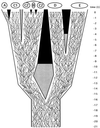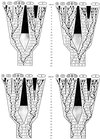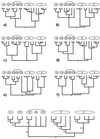Phylogenetics and the origin of species
- PMID: 9223259
- PMCID: PMC33696
- DOI: 10.1073/pnas.94.15.7748
Phylogenetics and the origin of species
Abstract
A recent criticism that the biological species concept (BSC) unduly neglects phylogeny is examined under a novel modification of coalescent theory that considers multiple, sex-defined genealogical pathways through sexual organismal pedigrees. A competing phylogenetic species concept (PSC) also is evaluated from this vantage. Two analytical approaches are employed to capture the composite phylogenetic information contained within the braided assemblages of hereditary pathways of a pedigree: (i) consensus phylogenetic trees across allelic transmission routes and (ii) composite phenograms from quantitative values of organismal coancestry. Outcomes from both approaches demonstrate that the supposed sharp distinction between biological and phylogenetic species concepts is illusory. Historical descent and reproductive ties are related aspects of phylogeny and jointly illuminate biotic discontinuity.
Figures






References
-
- Dobzhansky T. Genetics and the Origin of Species. New York: Columbia Univ. Press; 1937.
-
- Mayr E. Am Nat. 1940;74:249–278.
-
- Otte D, Endler J A, editors. Speciation and Its Consequences. Sunderland, MA: Sinauer; 1989.
-
- Martin G. Nature (London) 1996;380:666–667.
-
- McKitrick M C, Zink R M. Condor. 1988;90:1–14.
Publication types
MeSH terms
LinkOut - more resources
Full Text Sources
Other Literature Sources

